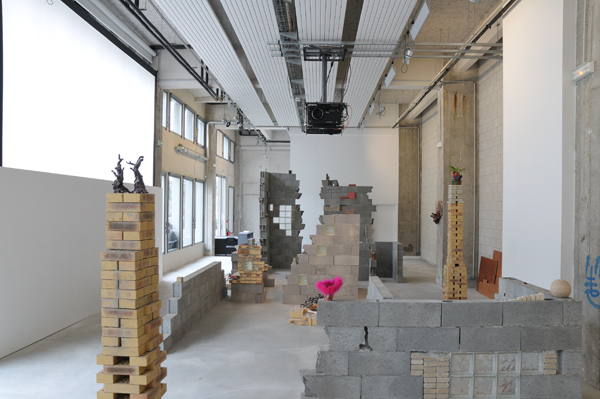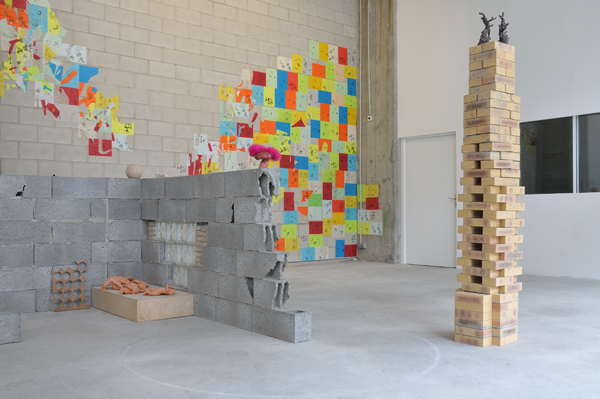Sarah Tritz, Capriccio cherche comtesse

- View of the Sarah Tritz exhibition "Capriccio cherche comtesse", Bétonsalon - Center for Art and Research, Paris, 2008. Image: Aurélien Mole
This exhibition is realized in partnership with Leroy Merlin
In order to set Bétonsalon within its social and geographical context - which is composed of industrial architecture, housing and shops - the artist Sarah Tritz will be working on site for fifteen days to realize a work of art made of breeze-blocs and bricks amongst other materials, creating an installation within the walls of the gallery.
Different kind of activities will be performed within the exhibition, such as workshops, guided tours, gigs… For instance, the artist has been invited to programme a series of "rendez-vous", an opportunity to welcome the input of several authors whose practices will highlight the work of Sarah Tritz. It is also a way to support emerging authors and composers who will produce original interventions responding to Sarah Tritz’ s invitation.
Sarah Tritz was born in 1980. She lives and works in Paris. She has recently exhibited her work at the Maison du livre, de l’image et du son (Villeurbanne, 2008), at La suite (Chateau-Thierry, 2007) and at La Station (Nice 2006) as part of collective exhibitions. She had her first solo exhibition, Un joyeuxnaufrage!, at the Espace d’art contemporain Camille Lambert of Juvisy/Orge, and has just completed a residency in Berlin at ’Visite ma tente’, a residency founded by SMP (Marseille). Capriccio cherche comtesse is her first solo exhibition in Paris.

- View of the Sarah Tritz exhibition "Capriccio cherche comtesse", Bétonsalon - Center for Art and Research, Paris, 2008. Image: Aurélien Mole
The works of Sarah Tritz present themselves as composite wholes shaped by an original rhythm that is each time particular to them. This rhythm is close to a mood, like an internal music, and serves to organise - from the inside - a play of forms that on leaving this codified arrangement appear to return to their initial obscurity. From the outside, the group struggles to agree; nothing moves. Our eyes hesitate, stumble, shocked by certain presumed affinities. Elements even seem to clash. From the inside, they all take their proper place. A circulation is established, our eyes follow its path and links come to life. We are invited to experience.
In fact the group functions organically. The engine behind this burgeoning display of life is the imagination. An imagination that is backed up by the will to create order. The raw material (meaning the remnants of past experiences) is made up of all kinds of documents, autobiographical or fictional, as suits, and of objects found, modified or produced. This initial raw material simmers away from day to day to subsequently be built and rebuilt at the mercy of newly produced installations. To give form to life, to one’s own life, is a task that must constantly be undertaken anew. In this sense, we witness a blooming forth that is constantly expanding and that mobilises a dynamic network between on the one hand, our emotional connection with the world and the exacerbation of feeling, translated by forms that are constantly moving between the appearance of being flat and the two-dimensional, and are completely consecrated to sight; and on the other, the search for a plasticity consecrated to touch; and it is all swept up in an effort to unite so that the whole stands firm. Things become fixed. From this unity, there then emerges an invitation to resuscitate the play of forms that initially appeared to be “half-dead”. After the almighty creative power of the game, we call to the other. Without this, nothing would exist.
We must take Sarah Tritz at her word. The clue is in the title: she places herself under the sign of caprice. Meaning what? Caprice, or capriccio, refers to a genre of painting which is generally associated with rococo, and of which the particularity is to represent landscapes punctuated with ruins. The ruins are on the whole invented, truncated and arranged according to the demands of the composition of the painting; or simply copied from real edifices, but inevitably placed in a fictional context that favours a sense of the bizarre and of strange and fantastical associations. In the end, the architectures that are painted are always imaginary.
At first glance, one thinks one is looking at an ode to the past. Very quickly it is the historical sentiment that predominates, the events are filtered and reshaped by the artist, the processes of transformation governed only by the artist’s fancy. It would seem that Sarah Tritz shares a family likeness with the caprice. But do not see a deliberate method in this. Rather an other music, the introduction of a new rhythm searching for resonances.
Clara Pacquet
Translated by Elizaveta Boutakova

Share